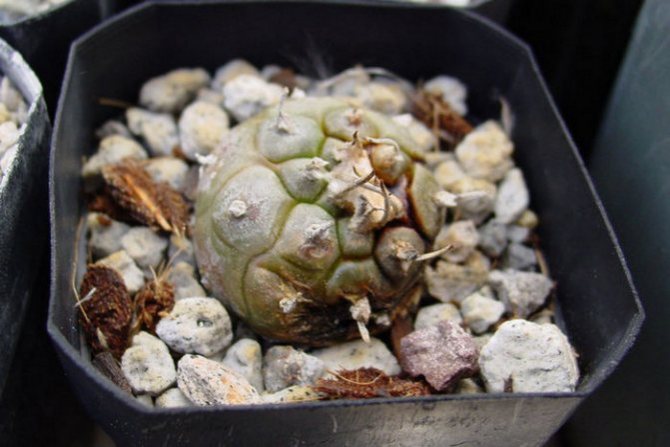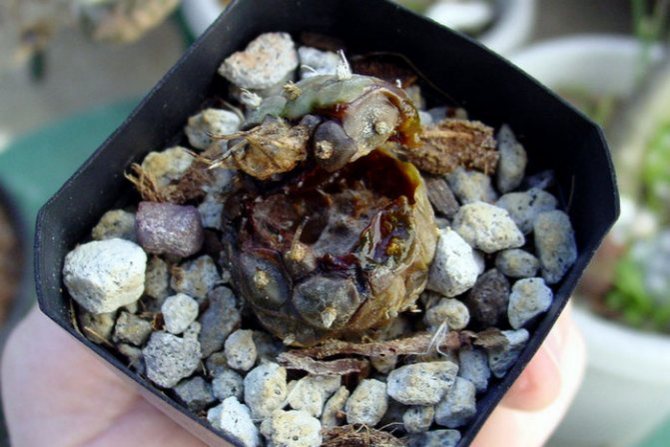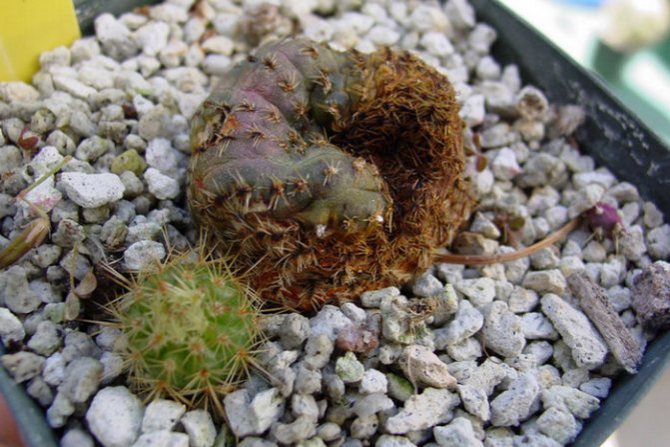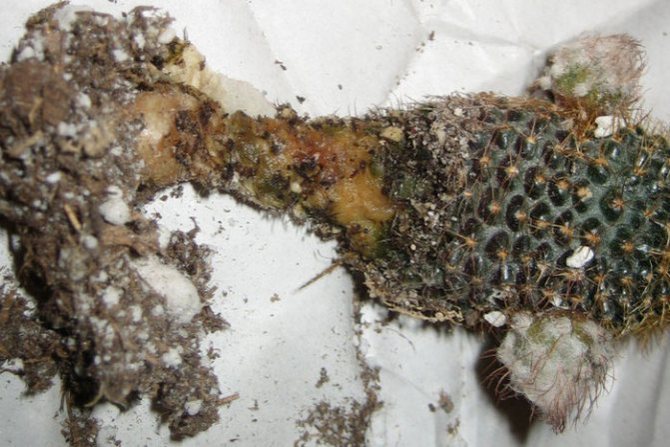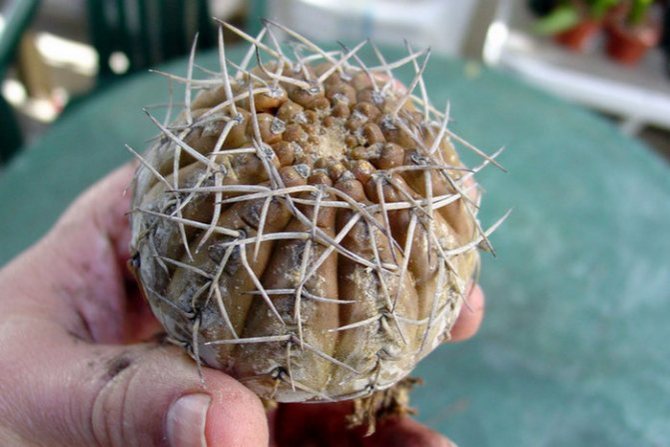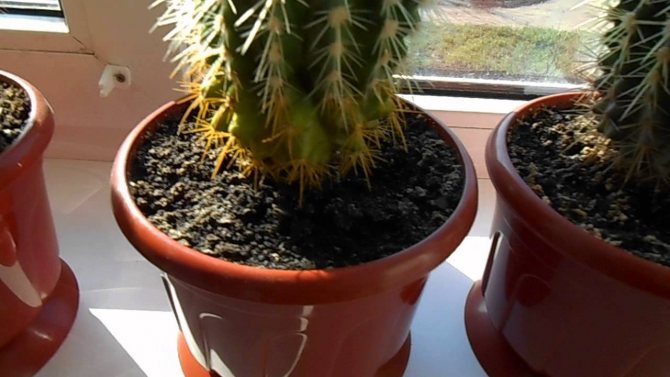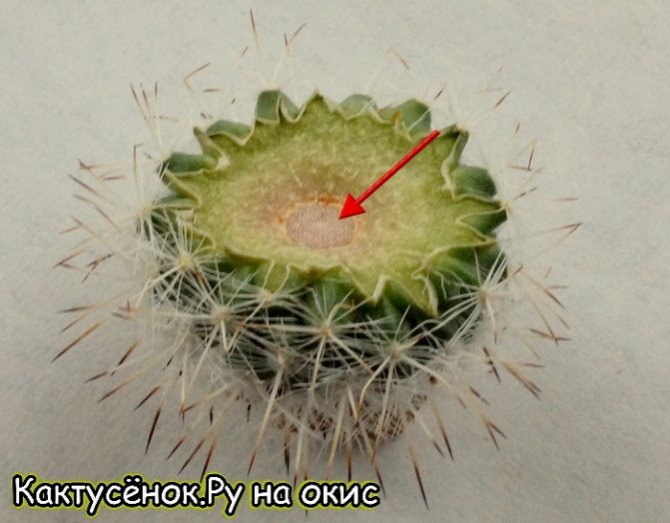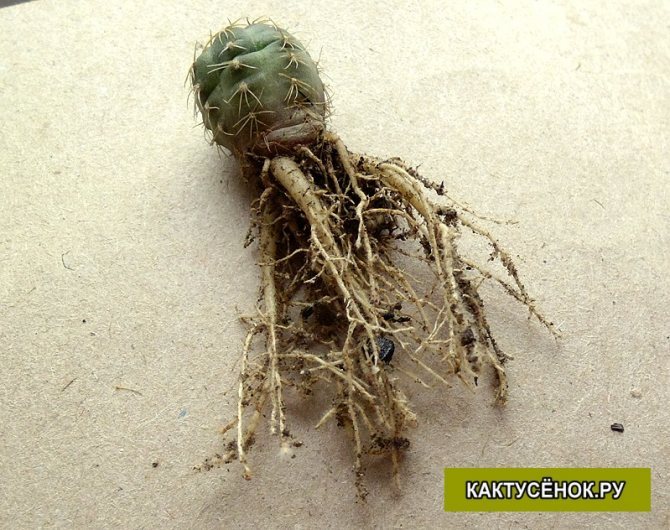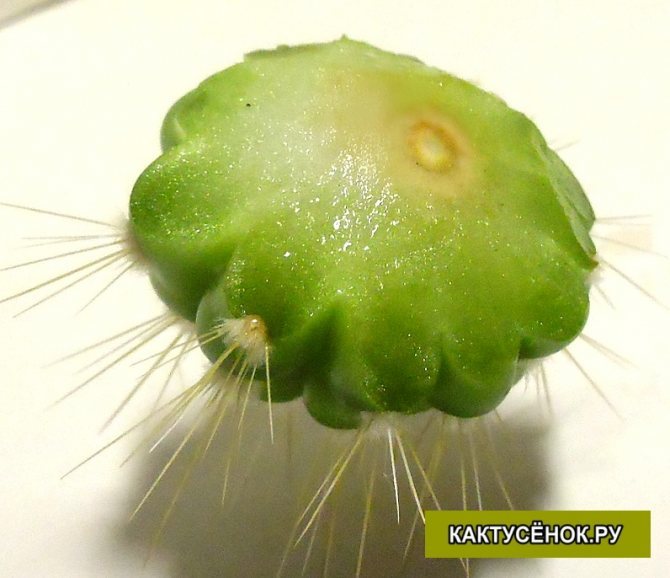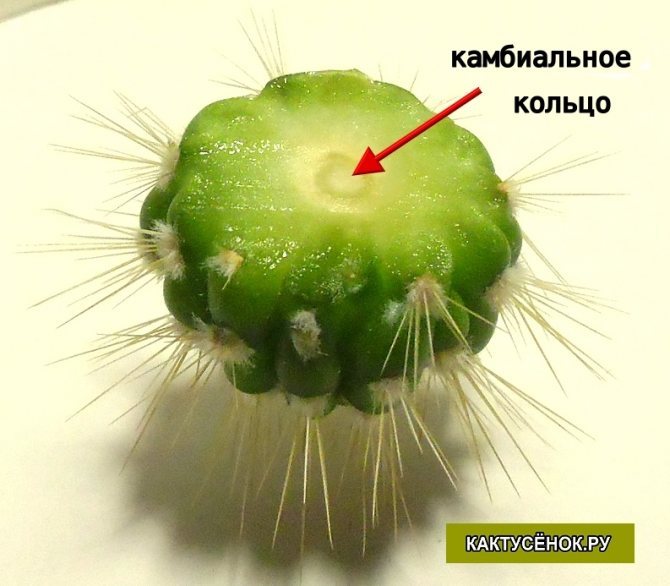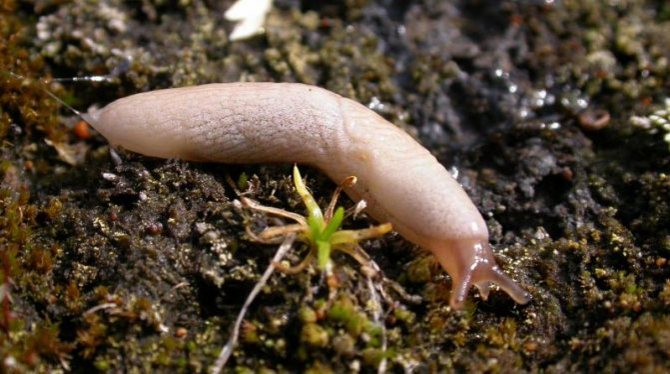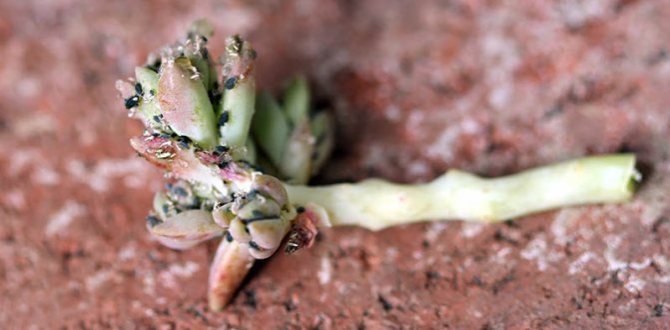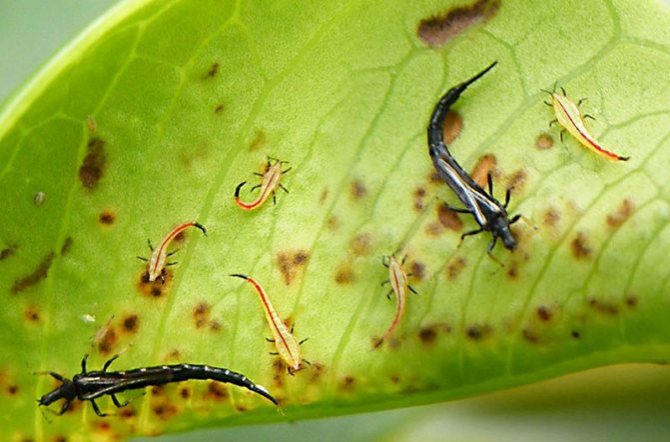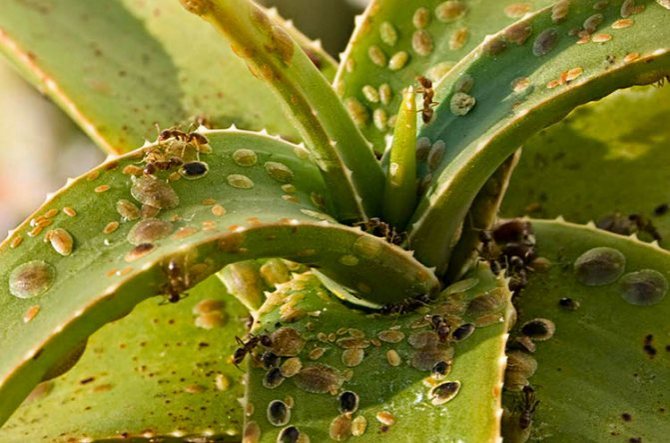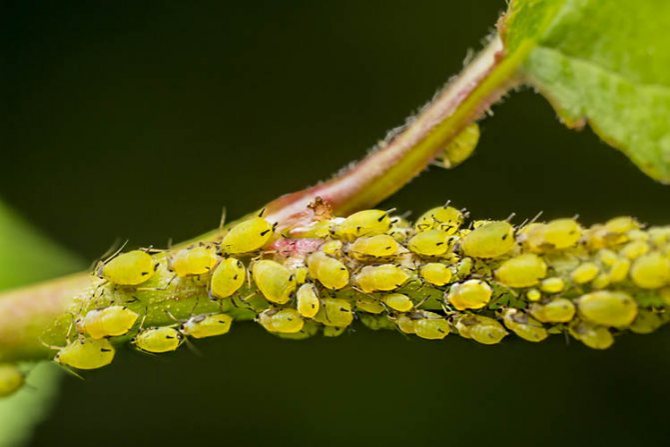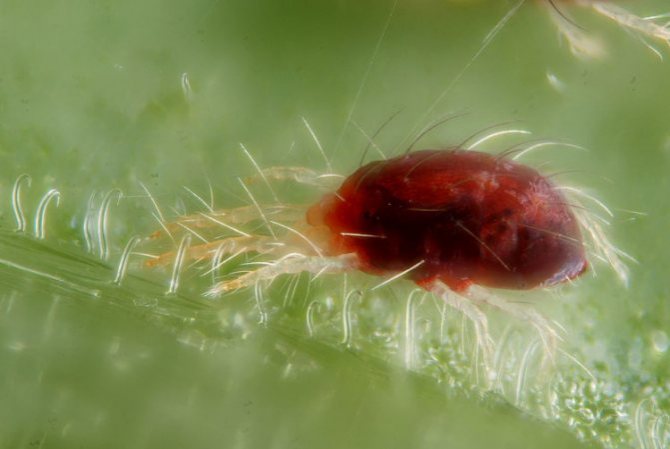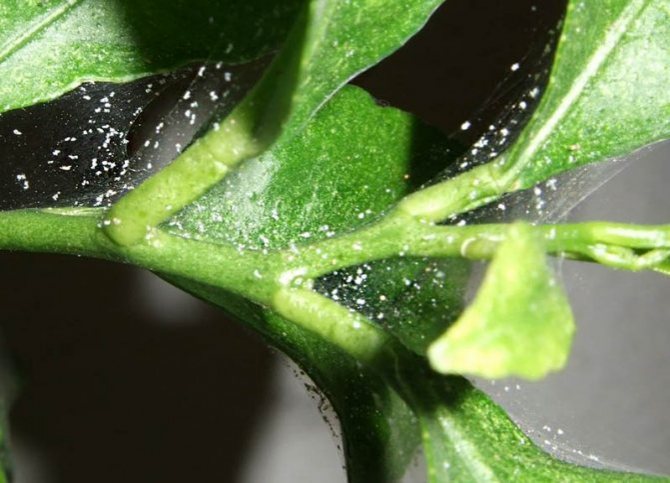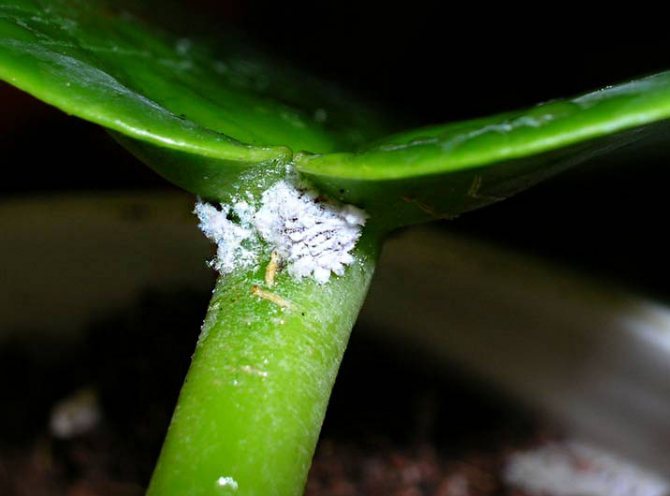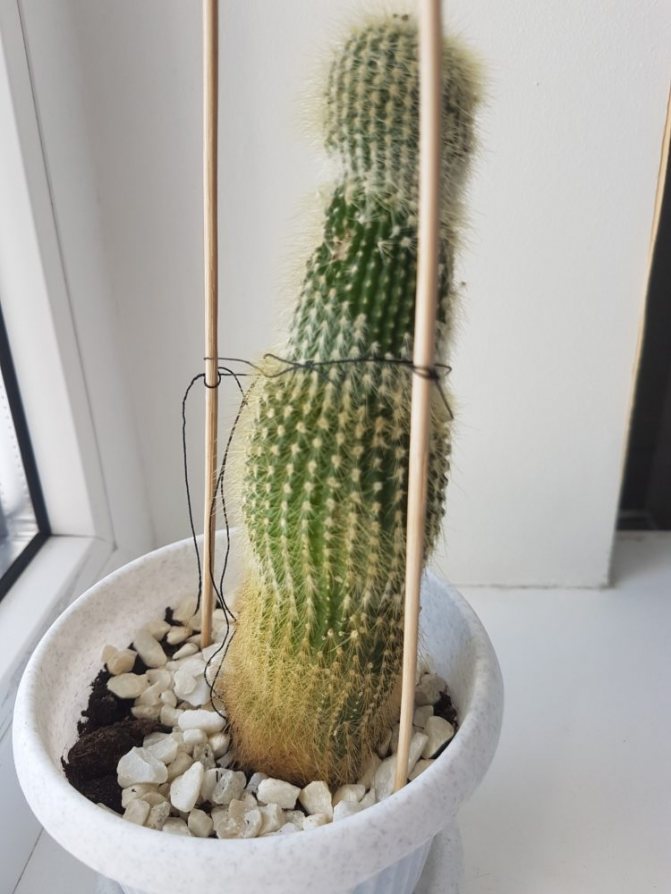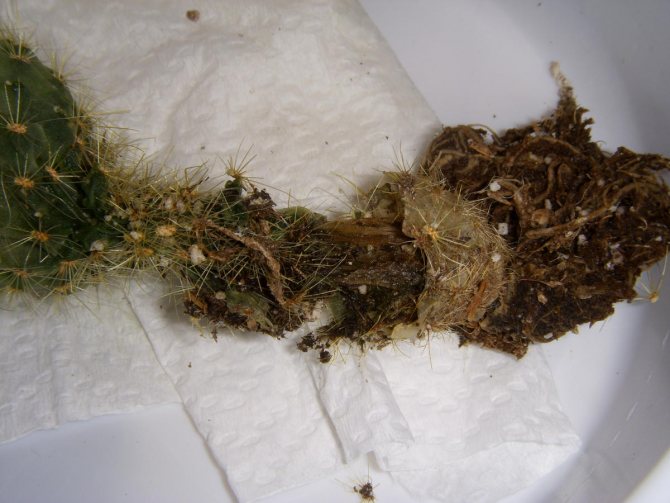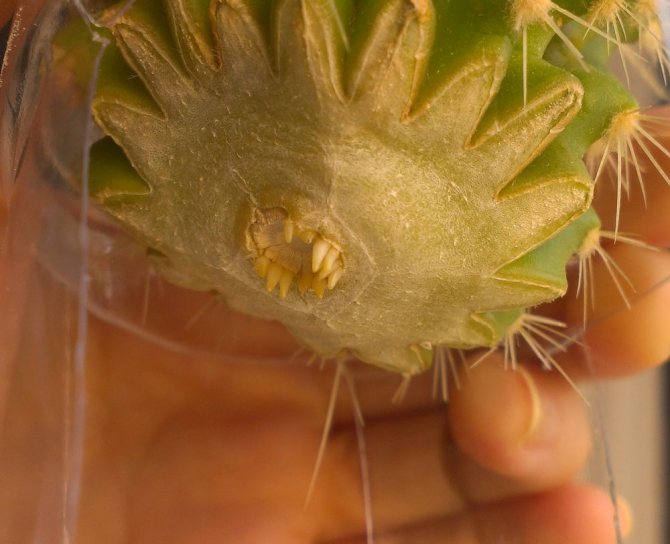Posted in Cacti, Care Published 03/01/2019 · Comments: · Read: 8 min · Views: 4 317
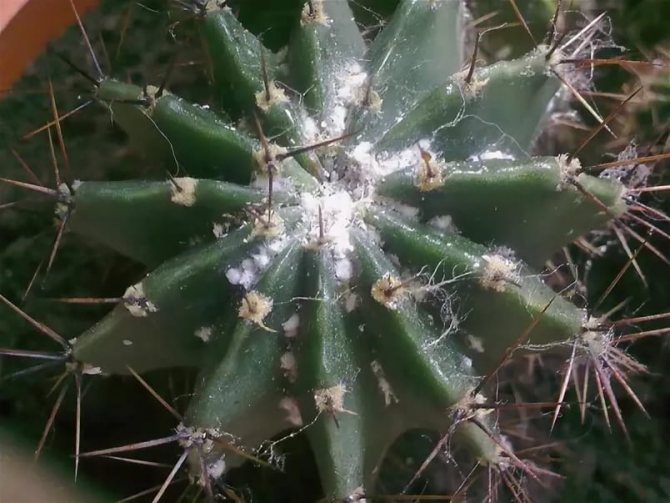
Cactus are a large family consisting of tropical, mountain and desert succulents, which have strong immunity and are equipped with various adaptations to get water where there is practically no water and to endure the scorching sun. However, climate change, improper care and inappropriate conditions can seriously impair plant health. Cacti begin to wither and other alarming symptoms appear, for example, a white coating on the trunk, what is this sign and what activities are required for an exotic guest?
Turns yellow
The top of the cactus or its shoots begins to turn yellow. The cause of the disease can be:
- Pests.
- Diseases.
- Lack of useful ingredients in the soil.
If the reason is a lack of fertilizer in the soil, then this omission must be corrected as soon as possible.
Coping with yellowness is not so easy, even if the treatment was carried out according to the rules. The people call this disease "jaundice", it can last from several weeks to several years.
If you take a stalk from a sick cactus, then there is a high probability that over time it will also turn yellow.
It looks like a cactus that turns yellow:
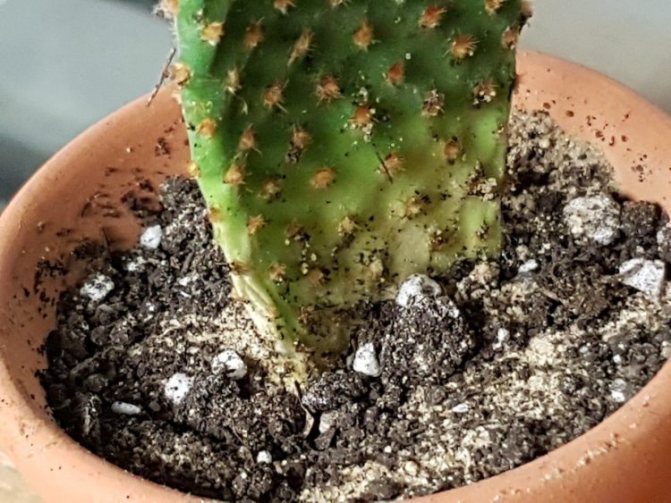

Read more about how to understand why a cactus turns yellow, and whether it is dangerous, read here.
Spider mite
Sooner or later, almost all growers who have large collections of home flowers come across this "friend". It is enough for a mite to start on one copy and soon all the plants are entangled in its thinnest cobweb.
Most often, the parasite starts up on indoor vegetation with increased dryness and air temperature, such conditions are very popular with the spider mite.
He is a polyphage and not particularly picky in choosing a plant, however, he prefers succulents with a fleshy and juicy aerial part. The mite pierces the skin and sucks out their vital juices. It is much easier to detect the parasite on such specimens than on ordinary indoor flowers.
Signs of infection
A spider mite is a tiny insect, the size of which does not exceed ¼ mm. It is quite slow, but at the same time has a fantastic reproduction rate. After a couple of days, a colony of mites populates almost all surfaces of the succulent, multiple yellow or brownish specks appear on the affected areas. The skin of cactus, damaged by these insects, is not restored.
Gradually, the size of the spots increases, they merge, and the foliage dries up. The plant is almost completely covered with cobwebs; on the tips of leaves and shoots, you can see a moving mass consisting of tiny mites. The growth of the succulent slows down, the buds wither and fall off.
Having found signs of infection of a cactus with a spider mite, it is impossible to hesitate, emergency treatment is required until the specimen dies.
Getting rid of the succulent from the parasite
If ticks have just attacked a green pet, you can try to remove them with folk remedies. To do this, you can spray and wipe its parts with an alcohol solution, laundry soap, garlic tincture.
A mixture of the following components is more effective:
- denatured alcohol (3g);
- green soap (4g);
- anabazine sulfate (2d).
They are bred in a liter of water and smeared with the composition of the affected parts of the succulent. The treatment is long-lasting - it lasts 20-25 days, the procedure is performed every 3 days.
There are other drugs that work even faster:
- 0.06% Karbofos - cactus needs to be processed 2-3 times a week.
- A decoction of cyclamen tubers - 0.1 kg of tubers are boiled in a liter of water, filtered and the liquid is applied to the affected plant. Enough 2 procedures with a weekly interval.
- Ethersulfonate - the solution is prepared from 1 g of the product per liter of water. It eliminates parasites at all stages of development - adult ticks, eggs and larvae.
After treatment, it is recommended to treat the succulent with this composition every 10-12 weeks for preventive purposes.
Prevention
It is easier to isolate indoor vegetation from parasites than outdoor crops. To do this, it is enough to adhere to some rules:
- Newly purchased copies should be placed separately from the rest. The minimum duration of quarantine is 1 week.
- It is advisable to treat surfaces located next to the pot with alcohol or other disinfectants.
- The soil used for planting plants must be sterilized - spilled with boiling water, ignited in the oven, microwave, or kept in a water bath.
To keep the air humidity at the proper level, you can install an aerator. It is better to irrigate cacti that are allowed to be sprayed during the summer heat and the operation of heating devices.
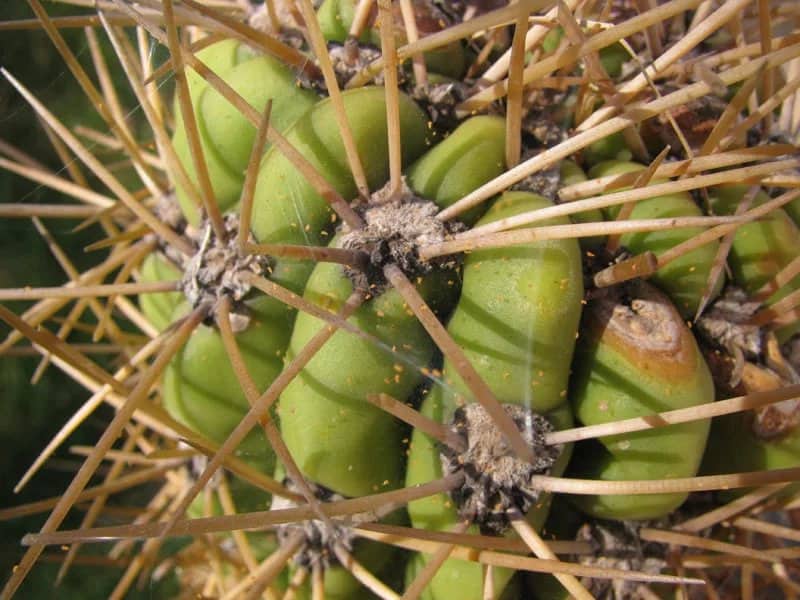

Pests
Basically, the cactus infects spider mites or worms.
Worms can be recognized by their white powder-like patches as they gather in groups. This is what this insect looks like:
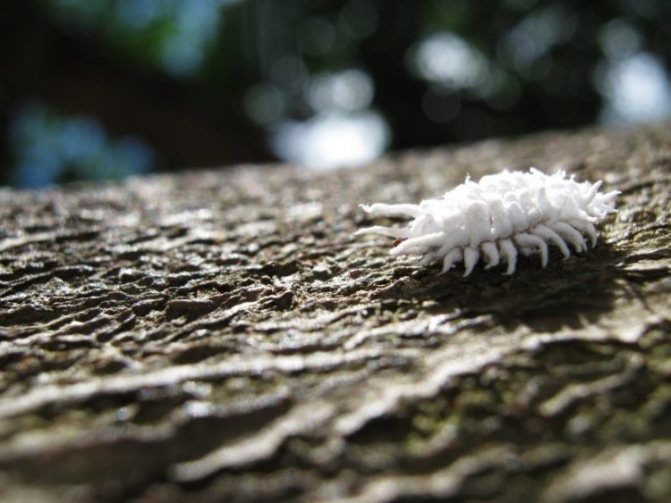

Learn how to save a cactus from a mealybug and rid the plant of white bloom, find out in this material.
A spider mite is a small red insect that winds a web between the spines of a cactus.
Fungal diseases
After viral diseases, fungal diseases are most dangerous for cacti. They are difficult to fight with, but they can be cured. Immediately separate diseased specimens from healthy specimens.
Gray mold
Description:
The disease affects germinating seeds. Some seeds are infected. This is manifested by brown spots on the seedlings. The development of the disease leads to the death of seedlings. The disease also affects fully formed cacti.
Treatment:
You can cure gray mold by treating the seeds before sowing with a special fungicide.
Seedling gangrene
Description:
The cause of the disease is a fungal attack. Plants can contract the disease through infected seeds or soil. Seedling gangrene is manifested by blackening and death of the tissues of the base of the stem and roots.
Treatment:
Diseases are promoted by dense planting of seedlings, eliminated by disinfection of soil and seeds.
Cactus rot
Description:
The disease strikes in the spring. Rot is facilitated by the lack of airing the room and watering the plants when it is cold. Affects the base of the main shoot and the root collar.
Photo:
Treatment:
In the spring, spray cacti with fungicidal preparations.
The disease also threatens the roots. If you water a cactus abundantly, and the roots were damaged during wintering, they will begin to rot.
Mealybugs
If white discharge appears on your cactus, then most likely this is a manifestation of vital activity mealybug.
It has several names: hairy aphid, stem bug
... This pest lives in the folds of the cactus stem or thorns. Traces of his stay -
this is a white discharge, in which the females lay eggs.
Usually, these hairy lumps can be found in places where water does not get into.
The hardest to find a bug is on cacti that are covered with white fluff or white hairs. Mealybugs are 5-7 mm in size and have a white waxy coating on the body. They live on all the cacti in your collection.
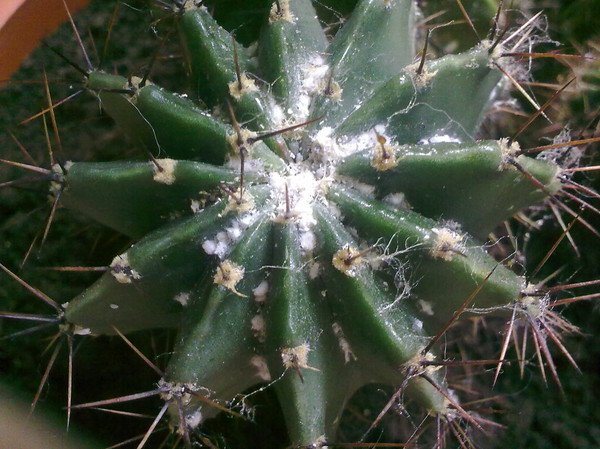

Fight this pest can be dealt with in different ways. For example, collect them by hand using a cotton swab dipped in a weak alcohol solution - ¼.
But this method is only suitable for lightly damaged plants.
If there are a lot of worms, then you can wash them off with a strong jet of water. Place the rubber hose on the faucet, and press the free end with your finger to form a powerful jet and direct it to the cactus.
To improve the effectiveness of the treatment, add dish detergent to the water.
It is also good to treat the plant with a pesticide and be sure to inspect the roots of the cactus, there may be root worm.
Important! If the cacti are sick, do not rush to destroy them. Almost every disease, if diagnosed correctly, can be prescribed the correct treatment!
Root nematode
These are worms of microscopic size - no more than 0.5 mm in length, translucent, can only be seen under a microscope. Nematodes are quite rare; they prefer moisture-consuming, loose and nutritious soils. The problem is that it is difficult to spot it right away. Signs: growth retardation and stunting, change in tissue color - the stems become paler, sluggish, thinning of the top of the cactus. The main symptom is the appearance of spherical swellings or growths (gall) on the roots:
Control measures. All affected parts of the roots are cut off, the whole plant is treated with alcohol, and the roots are given a hot bath. For this, the cactus roots, peeled from the ground, are dipped in hot water at a temperature of about 70 ° C to the root collar for 30-60 seconds. Or keep at 50 ° C for 15 minutes. After the root bath, the entire root system is sprinkled with crushed coal. If we talk about chemicals, then it is believed that agents based on imidacloprid are effective against nematodes - these are Confidor (1 g per 5 liters of water), Tanrek, Vermitic. Plants are immersed in a solution completely and roots and stem. To prevent the appearance of nematodes on a healthy plant, you can sterilize the substrate. In any way - steamed in boiling water, heated in the oven or microwave.
Any disease and appearance of pests is much easier to prevent than to cure. There are special hygienic procedures that should become mandatory for a novice cactusist, especially if the cactus is not one, but several, or a whole collection. Hygienic procedures include regular spraying of cacti with a very fine spray bottle, disinfection of planting containers, tools for transplanting, grafting, picking, etc. Sterilization of soil and sand before transplanting. To disinfect the instrument, alcohol is used; in the absence of it, it can be replaced by simple scalding of boiling water. Pots and bowls are washed and also poured over with boiling water. The soil and sand are fried in the oven, or spilled with a solution of potassium permanganate.
Reproduction
The female forms cotton-like clusters from the secretions, which she uses to lay eggs. At a time, the female can lay about 2,000 microscopic eggs in cooked fluffy formations, which they attach in the axils of the leaves or along the veins. The deposited testicles are protected by voluminous cotton secretions and therefore are not afraid of water. The grown larvae spread throughout the plant, even at the root collar and on the roots.
In scale insects, sexual dimorphism is clearly expressed.
Only males have wings, strong limbs, abdomen, two tail filaments.
How to fight?
Folk recipes and chemicals are available to get rid of mealybugs.
The first option is safer, but ineffective in case of mass infection.When using chemicals, it is extremely important to be careful, to carry out the procedure in a ventilated area, to avoid contact of the treated cactus and animals, children.
Folk remedies
| Way | Preparation | Application rules |
| Field horsetail infusion | In pharmacies, you can buy a ready-made tincture (sold as a diuretic). Before use, mix the infusion with water (1: 3). You can also use fresh horsetail shoots. For this:
The infusion is diluted with water in a ratio of 1: 5. | Spray the infected cactus liberally once a day. |
| Oils | Add 2 tablespoons of any vegetable or olive oil to 1 liter of water. Stir well. | Spray the plant 2-3 times a day. Prepare a fresh solution for each procedure. |
| Soap and alcohol | Mix 15-20 g of any liquid soap, 10-15 ml of denatured alcohol and foam well. Pour 1 liter of water. | Spray the cactus no more than 1 time in 2 days. |
| Garlic infusion |
| Take a cotton pad or brush, moisten it in the infusion and thoroughly wipe the cactus. Repeat 1-2 times a day. |
Chemicals
| Name | Preparation and application of the solution |
| Aktara |
|
| Spark | Capacity for solution preparation - 10-15 liters.
|
| Apploud | The solution can be prepared directly in the sprayer. For this, water and the drug are taken in a proportion of 1 liter per 1 g of the drug. Then the plant is thoroughly sprayed. The first signs of the destruction of pests will be noticeable only after 1.5-2 weeks. |
| BI-58 | The drug is available in ampoules. 1 ampoule is diluted in 5 liters of water. The solution is thoroughly mixed and poured into the sprayer immediately after preparation. |
When using chemicals, be sure to use personal protective equipment: gloves, a respirator and special glasses. After mixing the solution, ventilate the room.
Fungus problem
The fungus most often contributes to the spread of rot on the plant. The reasons are cold weather and waterlogged soil. The most common fungal infections are:
- Late blight - decay starts from the neck of the cactus. Treatment consists in cutting off the decayed parts of the flower down to healthy tissue. Then they dry out and take root.
- Fusarium - the root system is affected. The cactus stops growing, becomes covered with rusty spots, turgor softens. The cactus is treated with fungicides, isolated from other plants, and placed in a dry and warm room.
- Helminthosporosis - affects crops in spring. This is facilitated by high humidity and low temperatures. Treatment consists of removing the contaminated soil. If it is suspected that the seedlings are infected, they are removed from the soil and monitored for some time.
In this case, the air should be dry and warm, the plants themselves do not come into contact with each other. If diseased seedlings were found, they are removed, and only healthy plants are planted in the soil.
This is how a cactus affected by a fungal infection looks like:
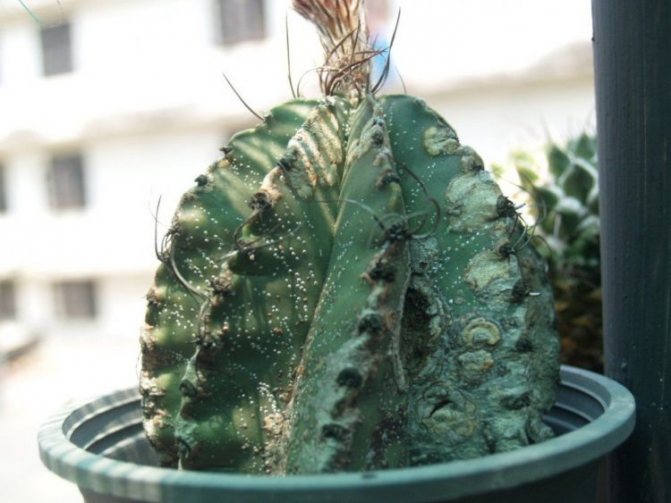

Mottling
Spots are caused by physiological factors, parasites and harmful bacteria. Most often, it is the latter that are the cause.
Spots can take the form:
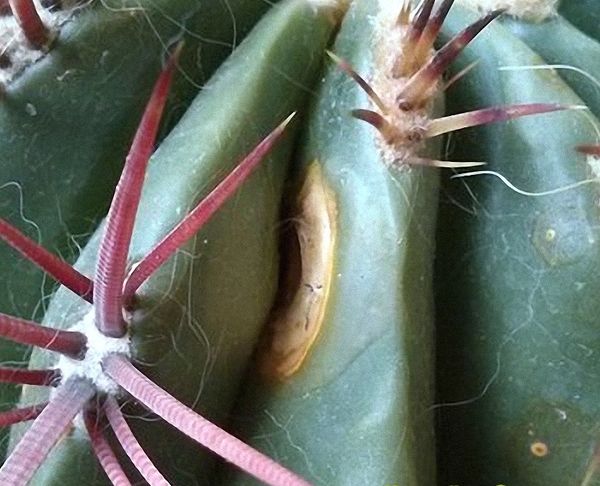

Unlike rot, cutting them off is useless: spots will appear in new places, even if old ones have been removed. Intermittent spraying with fungicides, for example, "Topaz", restrains the infection. It is important to strengthen the plant's immunity by placing it in a dry, sunny place. The spots will not disappear from this, but they will stop growing, and moreover, new ones will not appear.
However, if you notice dry spots of light or dark brown color on a cactus, this is most likely brown spot (anthrocnosis) - a fungal disease, and in order to save the plant, you need to remove the spots and treat with fungicides according to the standard scheme.
Why can a plant turn yellow at the base?
Sometimes cacti change color for reasons that cannot be called the norm.
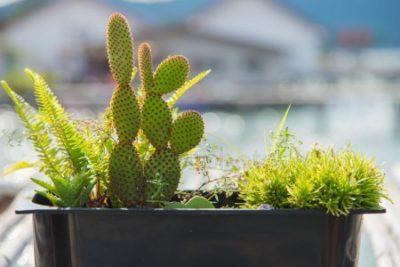

"Unaccustomed" to the sun
cactus can easily get burned from direct contact with rays... If water gets on the flower (especially cold), it can react with brown spots and yellowness. Cactus can turn yellow from exposure to drafts, as well as from nutrient deficiencies in the soil.
When a cactus for some reason changes color from below, above the neck of the root, this does not bode well. If at the same time softening of the stem is observed or if the flower turns yellow on one side, and on the other is covered with black spots, this means that the root has been flooded with water, and the decay process is actively going on. Unfortunately, it is hardly possible to save the flower.
Prevention measures
You can protect a cactus from a dangerous mealybug by adhering to preventive measures:


Before buying any new plant, be sure to carefully inspect it for diseases and harmful insects. After the purchase, it is advisable to keep the new plant in quarantine for 1-2 weeks.- Inspect every day for rot, disease, or traces of harmful insects (what diseases and pests can kill a plant?).
- Practice cactus hygiene. Periodically arrange water treatments for the prickly handsome man.
- When transplanted into new soil, it should be disinfected by calcining over a fire or freezing.
- Observe the watering regime.
- Remove fallen needles and faded buds in a timely manner.
The cactus cannot be called a capricious plant, but it also requires care and attention from the grower. Without proper care, the flower stops blooming, begins to turn yellow, becomes soft, stretched out or bent on its side.
Even such strong and unpretentious plants as cacti are susceptible to attacks by insects and diseases... In order for the plant to please with a healthy look, do not forget to pay attention to it, take proper care of it. If the infection has happened, take urgent measures to combat the pest.
If you find an error, please select a piece of text and press Ctrl + Enter.
Temperature
One of the most important factors in the good health of succulents is the correct temperature during wakefulness and rest. The temperature of our apartments is perfect for many plants, and for a dormant period, a cool glazed loggia. If the frosts are strong in winter, then thermophilic succulents should be brought into the room, but placed away from the central heating batteries.
The optimum temperature for development and growth is 25-27 degrees Celsius. Higher temperatures and higher humidity can "cook" exotic succulents. Plants in heat, without fresh air supply, can die.
At low temperatures + 10-15 degrees, plants slow down their growth and get stronger - this usually happens during the winter rest period. But if waterlogging occurs during this period, then this leads to severe fungal and bacterial diseases and the reproduction of some pests.
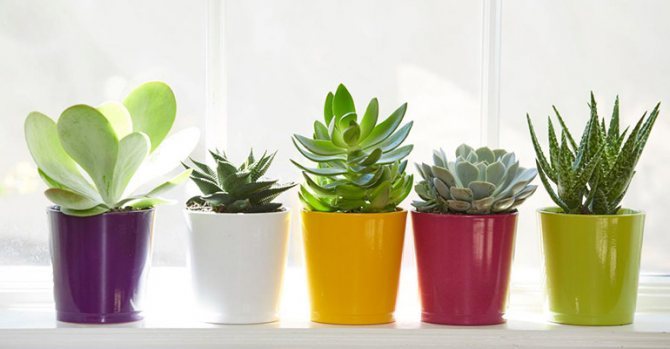

Further care of the cactus
Sticky drops on orchid leaves: causes and treatments
After the plant is healed, so that in the future it does not have any health problems, it is necessary to create favorable conditions for keeping.
Temperature and humidity
For cacti, which are native to the desert, it is necessary to provide a sufficient amount of sunlight. They feel good when placed in direct sunlight, but in the summer in the midday heat it is still better to shade them so as not to provoke a burn.
Summer temperatures are preferred over 26-28 ° C heat. Humidity they need at least 40-50%. the preferred air temperature in winter is no more than 15-18 ° C warm. Most of the varieties (except for the densely pubescent) will easily tolerate a temperature drop of up to + 5 ° C. For people from the tropics, bright, but diffused light and humidity of at least 60% are required.
Watering
In winter, cacti are dormant and hibernate. During this period, the plants do not need frequent watering. Watering cacti is worth not more than once every two weeks, and in small quantities. With the arrival of spring, the amount of watering is gradually increased, and in the summer it is watered quite often (once every 3-4 days). From October, watering should again be limited. Water should be used only warm and purified.
How to understand that a cactus has dried up after winter
First, dry spots appear on the stem, the flower loses its decorative qualities, and eventually dies altogether. If a cactus grows even a little, new thorns appear on it and all green tissues remain alive, it is in good condition. If the stem is hard and the soil in the pot is very dry, then the cactus is clearly dying of drought, especially if it is located in an area of active sunlight.
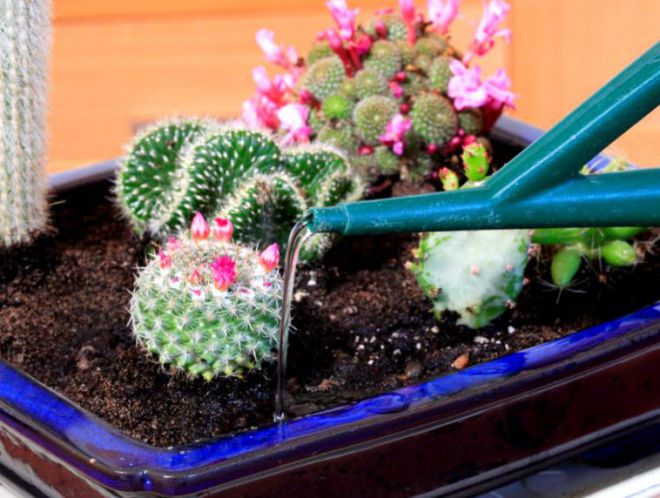

Watering through the pallet
The soil
For cacti native to the desert, the soil needs light, loose, moisture-permeable. For tropical succulents, the soil needs an airy, light and slightly acidic soil. The soil should have good drainage in the form of small pebbles, expanded clay or crushed bricks. The soil must contain sand, peat and charcoal.
Diseases of cacti and their treatment at home require special attention, since its future fate will depend on the timely assistance provided to the green pet. In order to cope with diseases and pests, you must always react quickly, and even better to suppress their appearance, properly caring for your beloved prickly friend.

